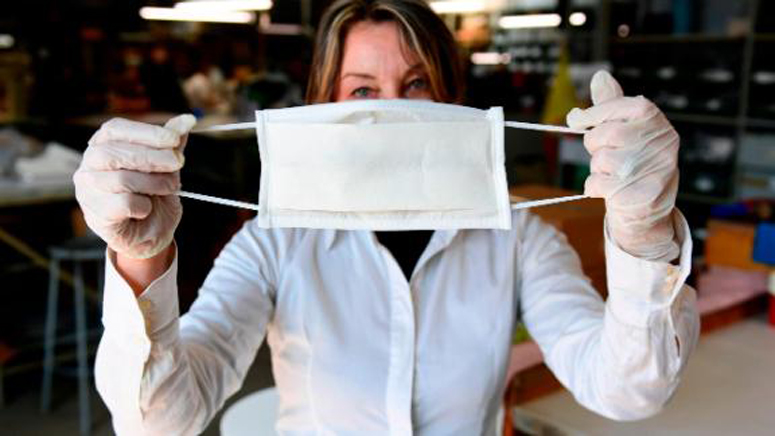(CNN) — Scientific evidence suggests that wearing a face mask can help stop the spread of Covid-19. New polling confirms that some regions of the country are taking that message to heart more than others.
Specifically, residents of the Northeast (led by New York) said they’re wearing masks at a significantly greater rate than the majority of the country.
That’s the finding of an aggregation of more than 6,000 respondents from Ipsos Knowledge Panel polling done for Axios (Axios/Ipsos poll). Over the last month and a half (May 8 to June 22), a fairly stable 48% to 51% of Americans told the pollster that they wore masks at all times when leaving home. Other pollsters, who have asked analogous questions during the same period, have shown similar numbers overall.
In the Axios/Ipsos polling, you can clearly see how much ahead of the curve New York (among the 28 states for which we had at least 75 respondents) and the Mid-Atlantic (see here for all Census division subsets) portion of the Northeast are when it comes to mask wearing. Of the over 750 Mid-Atlantic respondents, 64% say they are always wearing masks when they go out. As Ipsos did in a recent poll with the Washington Post, they were able to drill down to the state level in some instances too.
In New York, 67% say they’re wearing a mask at all times when they leave their house. That’s the highest percentage for any state for which there were at least 75 respondents polled.
Indeed, the Acela corridor more generally is leading the country in wearing masks. At least 60% of residents in Connecticut, Massachusetts, New Jersey, New York, Pennsylvania and Maryland indicated that they were always wearing masks.
New York and the surrounding areas were hit the hardest by the coronavirus pandemic a few months ago, so it shouldn’t be surprising that there is a clear movement to stem any recurrence of that.
The only other state in the country where more than 60% of residents said they were always wearing masks was California (64%).The Pacific division (which is made up mostly of California) has the highest mask-wearing public (58%) outside of the Northeast. That’s mostly a California phenomenon, as less than 50% said they wore masks in the other states (Oregon and Washington) of the Pacific division for which we have a sample of at least 75.
As a rule, other parts of the country don’t adhere to mask-wearing like the Northeast. The central part of the country in particular seems adverse to wearing masks.
Less than 50% of those in the Midwest (the East and West North Central) say they always wear a mask outside the house. Mask-wearing at all times when leaving the house at 34% is quite limited in the West North Central division.
The two other areas where mask-wearing is significantly smaller than average are the Mountain division in the West and the East South Central in the South. Less than 40% in either division told Ipsos that they always put on a mask when outside of their house.
Lastly, the other divisions of the South (South Atlantic and West South Central) feature average mask-wearing. This includes Florida and Texas, which are within the margin of error of the national percentage in terms of wearing a mask in public.
This polling data when matched with current rates of transmission is, on the whole, consistent with the growing scientific consensus that mask-wearing slows the spread of Covid-19. We’re dealing with small samples for a lot of states in the polling and there are plenty of potential confounding variables, so I don’t want to harp on this too much.
Still, when we limit ourselves to the 28 states where we have a sample size of 75 or greater, there does seem to be a correlation between the rate of reproduction (averaged over the aggregated period the Axios/Ipsos polling was in the field) and the percentage who said they wore masks. Rates greater than 1 mean every infected person is infecting more than 1 additional person on average, while rates less than 1 mean that every infected person is infecting less than 1 additional person on average.
States where the reproduction rate is above 1 have an average of 42% who say they always wear a mask when they leave the house. States where the reproduction rate is below 1 have an average of 51% who say they always wear masks when leaving home.
The relationship is far from perfect, but it is clearly evident. Some states with above average mask-wearing have above 1 reproduction (e.g. California). That’s what you’d expect in this type of simple exercise revolving around a complex problem. When you examine other ways of looking at spread, you see similar correlations. This includes looking at the percentage change in cases and the percentage change of positive cases over the last month and a half compared to earlier in the year, as well as a 50,000 foot view at the Census division level compared to the rate of reproduction.
It’s potentially another small indication that masks help in the fight to prevent Covid-19 from spreading.
The-CNN-Wire
™ & © 2020 Cable News Network, Inc., a WarnerMedia Company. All rights reserved.

